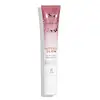What's inside
What's inside
 Key Ingredients
Key Ingredients

 Benefits
Benefits

 Concerns
Concerns

 Ingredients Side-by-side
Ingredients Side-by-side

Water
Skin ConditioningDimethicone
EmollientDicaprylyl Carbonate
EmollientRubus Chamaemorus Fruit Juice Extract
HumectantBetula Alba Juice
AstringentBetaine
HumectantGlycerin
HumectantCaprylyl Methicone
Skin ConditioningSodium Acrylates Copolymer
Polysilicone-11
PEG-12 Dimethicone
Skin ConditioningRubus Chamaemorus Seed Extract
Skin ConditioningPhenoxyethanol
PreservativePropanediol
SolventLecithin
EmollientHydroxyacetophenone
AntioxidantHectorite
AbsorbentEthylhexylglycerin
Skin ConditioningSodium Gluconate
Skin ConditioningCitric Acid
BufferingLinalool
PerfumingCitronellol
PerfumingAlpha-Isomethyl Ionone
PerfumingParfum
MaskingCI 73360
Cosmetic ColorantIron Oxides
CI 77742
Cosmetic ColorantCI 77891
Cosmetic ColorantWater, Dimethicone, Dicaprylyl Carbonate, Rubus Chamaemorus Fruit Juice Extract, Betula Alba Juice, Betaine, Glycerin, Caprylyl Methicone, Sodium Acrylates Copolymer, Polysilicone-11, PEG-12 Dimethicone, Rubus Chamaemorus Seed Extract, Phenoxyethanol, Propanediol, Lecithin, Hydroxyacetophenone, Hectorite, Ethylhexylglycerin, Sodium Gluconate, Citric Acid, Linalool, Citronellol, Alpha-Isomethyl Ionone, Parfum, CI 73360, Iron Oxides, CI 77742, CI 77891
Talc
AbrasiveSilica
AbrasiveHydrogenated Castor Oil
EmollientMica
Cosmetic ColorantMagnesium Stearate
Cosmetic ColorantZinc Stearate
Cosmetic ColorantButyrospermum Parkii Butter
Skin ConditioningOctyldodecyl Stearoyl Stearate
EmollientRubus Chamaemorus Seed Oil
Skin ConditioningBis-Ethylhexyloxyphenol Methoxyphenyl Triazine
Skin ConditioningEthylhexyl Triazone
UV AbsorberCaprylyl Glycol
EmollientEthylhexyl Palmitate
EmollientPhenoxyethanol
Preservative1,2-Hexanediol
Skin ConditioningJojoba Esters
EmollientEthylhexylglycerin
Skin ConditioningPEG-8
HumectantBenzotriazolyl Dodecyl P-Cresol
UV AbsorberTocopherol
AntioxidantSilica Dimethyl Silylate
EmollientAscorbyl Palmitate
AntioxidantButylene Glycol
HumectantAscorbic Acid
AntioxidantCitric Acid
BufferingSodium Hyaluronate
HumectantHexylene Glycol
EmulsifyingHelianthus Annuus Seed Oil
EmollientRosmarinus Officinalis Leaf Extract
AntimicrobialCI 73360
Cosmetic ColorantIron Oxides
CI 77742
Cosmetic ColorantCI 77891
Cosmetic ColorantTalc, Silica, Hydrogenated Castor Oil, Mica, Magnesium Stearate, Zinc Stearate, Butyrospermum Parkii Butter, Octyldodecyl Stearoyl Stearate, Rubus Chamaemorus Seed Oil, Bis-Ethylhexyloxyphenol Methoxyphenyl Triazine, Ethylhexyl Triazone, Caprylyl Glycol, Ethylhexyl Palmitate, Phenoxyethanol, 1,2-Hexanediol, Jojoba Esters, Ethylhexylglycerin, PEG-8, Benzotriazolyl Dodecyl P-Cresol, Tocopherol, Silica Dimethyl Silylate, Ascorbyl Palmitate, Butylene Glycol, Ascorbic Acid, Citric Acid, Sodium Hyaluronate, Hexylene Glycol, Helianthus Annuus Seed Oil, Rosmarinus Officinalis Leaf Extract, CI 73360, Iron Oxides, CI 77742, CI 77891
Ingredients Explained
These ingredients are found in both products.
Ingredients higher up in an ingredient list are typically present in a larger amount.
Ci 73360 is a synthetic red-pink dye.
This ingredient is used to add a violet color to cosmetics.
It is created by reacting phosphoric acid, ammonium dihydrogen orthophosphate, and manganese dioxide.
Ci 77891 is a white pigment from Titanium dioxide. It is naturally found in minerals such as rutile and ilmenite.
It's main function is to add a white color to cosmetics. It can also be mixed with other colors to create different shades.
Ci 77891 is commonly found in sunscreens due to its ability to block UV rays.
Learn more about CI 77891Citric Acid is an alpha hydroxy acid (AHA) naturally found in citrus fruits like oranges, lemons, and limes.
Like other AHAs, citric acid can exfoliate skin by breaking down the bonds that hold dead skin cells together. This helps reveal smoother and brighter skin underneath.
However, this exfoliating effect only happens at high concentrations (20%) which can be hard to find in cosmetic products.
Due to this, citric acid is usually included in small amounts as a pH adjuster. This helps keep products slightly more acidic and compatible with skin's natural pH.
In skincare formulas, citric acid can:
While it can provide some skin benefits, research shows lactic acid and glycolic acid are generally more effective and less irritating exfoliants.
Most citric acid used in skincare today is made by fermenting sugars (usually from molasses). This synthetic version is identical to the natural citrus form but easier to stabilize and use in formulations.
Read more about some other popular AHA's here:
Learn more about Citric AcidEthylhexylglycerin (we can't pronounce this either) is commonly used as a preservative and skin softener. It is derived from glyceryl.
You might see Ethylhexylglycerin often paired with other preservatives such as phenoxyethanol. Ethylhexylglycerin has been found to increase the effectiveness of these other preservatives.
Phenoxyethanol is a preservative that has germicide, antimicrobial, and aromatic properties. Studies show that phenoxyethanol can prevent microbial growth. By itself, it has a scent that is similar to that of a rose.
It's often used in formulations along with Caprylyl Glycol to preserve the shelf life of products.
This ingredient is a combination of red, black, and yellow iron oxide pigments. This combination of colors is usually found in foundation, because it results in a "skin" color.